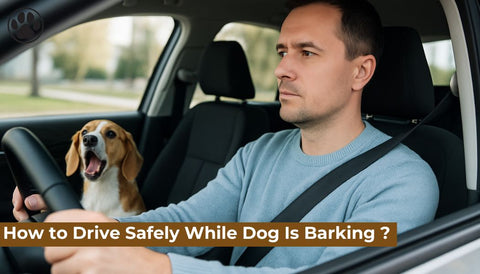
How to Drive Safely While Dog Is Barking
of reading - words
Driving requires full attention, but many dog owners face a common challenge: their pet barking in the car. Whether it’s excitement, stress, or a need to communicate, barking can quickly become distracting and dangerous. Understanding how to drive safely while dog is barking is essential for keeping both you and your four-legged companion safe on the road.
Why Barking Dogs Can Be a Driving Hazard
A barking dog might seem harmless, but the reality is that constant noise and sudden movements create distractions. Studies show that distracted driving is one of the leading causes of accidents. When your dog barks loudly or jumps around, your focus shifts from the road to your pet. This momentary loss of attention increases the risk of mistakes.
Beyond distraction, barking can also raise stress levels. Elevated stress reduces reaction times and decision-making abilities. For this reason, learning strategies for safe driving with a barking dog is crucial for every pet owner.
Understand Why Your Dog Barks in the Car
Before you can fix the issue, it’s important to understand the cause. Common reasons dogs bark while riding include:
-
Excitement – anticipating a park visit or walk.
-
Anxiety – feeling nervous about the car environment.
-
Territorial behavior – barking at pedestrians, cyclists, or other vehicles.
-
Attention-seeking – wanting interaction while you are focused on driving.
Identifying the trigger allows you to choose the right strategy. A dog barking from fear requires a different approach than one barking from excitement.
Train Your Dog Before the Journey
Training is one of the most effective solutions for driving safely with a barking dog. Start by introducing your pet to the car gradually. Allow them to sit inside while the engine is off, then reward calm behavior. Over time, extend the training to short drives.
Positive reinforcement, such as treats or praise, helps your dog associate car rides with calmness. If your dog barks when seeing people outside, consider using sunshades on the windows to limit external triggers.
Consistency is key. Training sessions of 10–15 minutes, repeated regularly, will help your dog learn that quiet behavior is rewarded while barking is ignored.
Use Restraints and Safety Gear
Unrestrained dogs can quickly become hazards. Not only do they distract drivers, but in the event of sudden braking, they can be injured. Using proper restraints ensures safety for both you and your pet. Options include:
-
Dog seat belts or harnesses designed for car use.
-
Travel crates that provide security and reduce external stimulation.
-
Pet barriers for SUVs to keep dogs in the back.
By keeping your dog in one secure location, you reduce their ability to bark at passing objects and prevent sudden movements across the car.
Maintain a Calm Environment
Dogs are sensitive to their surroundings. A noisy or chaotic car environment can increase barking. Consider the following adjustments:
-
Play calming music at a low volume.
-
Avoid sudden movements or loud conversations.
-
Keep the temperature comfortable, as heat or cold can cause agitation.
Calm environments reduce stress for both dog and driver, creating a safer trip.
Plan Breaks During Long Journeys
On longer drives, your dog may bark due to discomfort or restlessness. Just as humans need breaks, dogs require opportunities to stretch, relieve themselves, and release energy.
Plan a stop every 2–3 hours. Use this time to walk your dog and offer water. A tired and satisfied dog is less likely to bark excessively.
Teach the “Quiet” Command
Training your dog to respond to the “quiet” command is an invaluable tool. Start practicing at home in a distraction-free environment. Each time your dog barks, say “quiet” in a calm but firm tone. When the dog stops barking, reward with a treat or praise.
Once your dog understands this command, gradually introduce it during car rides. Over time, your pet will associate barking cessation with positive reinforcement, helping you maintain control even in stimulating environments.
Stay Calm Behind the Wheel
One of the most overlooked factors is the driver’s own behavior. If you become frustrated or yell at your dog, the barking often intensifies. Dogs mirror human emotions, so stress from the driver can amplify their anxiety.
Instead, maintain a steady voice, keep breathing relaxed, and avoid overreacting. Your calm demeanor signals to your dog that the situation is safe, reducing their urge to bark.
Avoid Dangerous Shortcuts
Some drivers attempt unsafe methods to quiet a dog, such as reaching into the back seat while driving or opening windows widely. These shortcuts increase risks significantly. Always remember: your first responsibility is controlling the vehicle.
If barking becomes unmanageable, safely pull over to a secure spot. Address your dog’s needs only once the car is stopped. This simple precaution prevents accidents caused by divided attention.
When to Seek Professional Help
Sometimes barking persists despite training and management. In such cases, professional help is valuable. Options include:
-
Veterinarians – to rule out health issues contributing to anxiety.
-
Dog trainers – for structured behavior modification.
-
Animal behaviorists – for in-depth analysis of barking triggers.
Investing in professional support ensures long-term safety and peace during rides.
Conclusion
Learning how to drive safely while dog is barking requires preparation, patience, and consistency. By understanding why your dog barks, using proper restraints, maintaining calm, and practicing training, you can minimize distractions. Safe driving is not just about protecting yourself but also about safeguarding your pet and everyone on the road.
Frequently Asked Questions
Why does my dog bark every time we drive?
Dogs often bark due to excitement, anxiety, or territorial instincts when they see people or vehicles outside.
How do I calm my dog in the car?
Use training, restraints, calming music, and regular breaks. Creating a positive association with car rides also helps.
Is it dangerous to drive with a barking dog?
Yes. Barking can distract drivers, and unrestrained pets may cause accidents. Always secure your dog and manage barking behaviors.
What if my dog won’t stop barking despite training?
If barking continues, consult a professional trainer or veterinarian to explore deeper behavioral or health-related issues.
Do calming products for dogs work during car rides?
Some calming sprays, pheromone diffusers, or anxiety wraps can reduce stress, but results vary depending on the individual dog.




